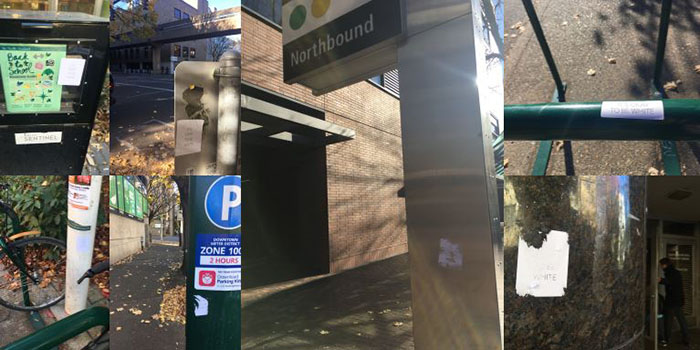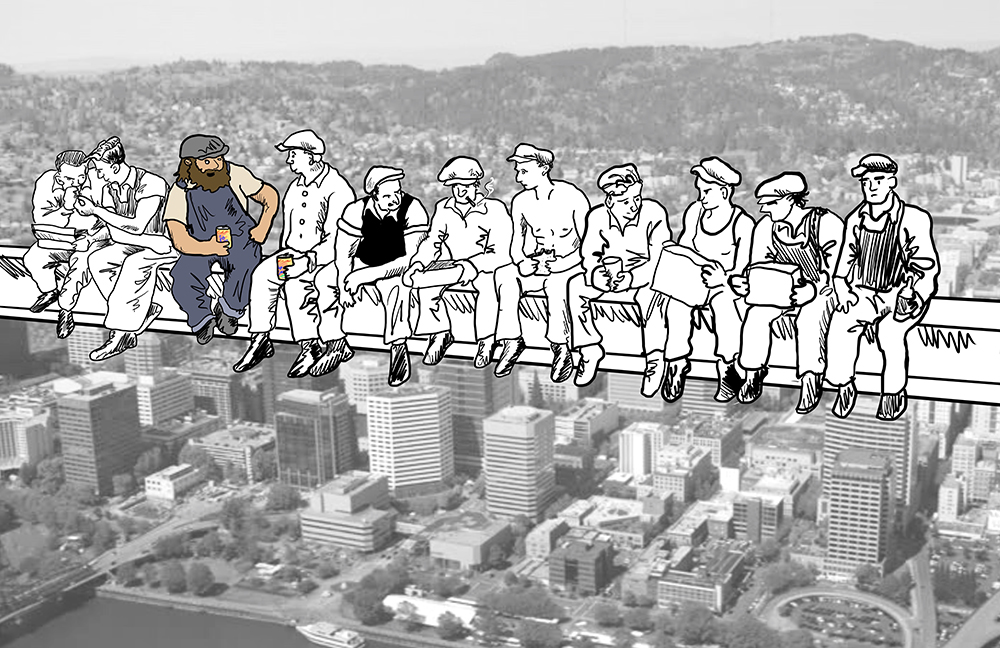On November 1, 2019 more than 100 racist stickers were found on the Portland State University campus. The stickers read “IT’S OKAY TO BE WHITE,” a white supremacist dog-whistle originating in 2017 from anonymous message board 4chan. On the same night, dozens of campuses in the US and Canada, including Ohio State University, Iowa State University, and the University of Manitoba were targeted with similar posters and stickers. The nationwide occurrence is a repeat of a 2018 effort organized on 4chan, during which the Anti-Defamation League recorded incidents on 14 college and university campuses across 12 states.
Less than a week later, posters and stickers were found outside of the Beaverton School District offices and in front Merlo Station High School, a public school of 133 students in Beaverton. The content references Patriot Front, which the Southern Poverty Law Center (SPLC) identifies as a white supremacist, neo-Nazi, neo-fascist group.
The message of the stickers may seem innocuous but is part of a larger campaign to recruit and to traumatize, according to Randy Blazak, a former sociology professor at PSU and local expert on hate groups and hate crimes. “These incidents—whether it is a violent attack or a sticker on the telephone pole are designed to make people feel more anxious and more unwanted and more traumatized.” White supremacy groups target schools to recruit “soldiers,” per Blazak, in particular, “heavily targeting white male students.”
Lieutenant Joe Schilling, Interim Chief of Police for Portland State University’s Campus Public Safety Office (CPSO) said it is still unclear who placed the stickers. CPSO conducted a preliminary investigation, but has since closed the file. Schilling said he consulted the City of Portland and local colleges and universities like Portland Community College, University of Portland and Reed College. “Nobody had any information for us.”
“Our thought is [the stickers] showed up overnight,” Schilling said. “Unfortunately PSU doesn’t have a lot of cameras that show outside areas like that.”
Although stickers were placed on transit stops, Schilling said that consulting TriMet hasn’t led to any breakthroughs. “We gave [TriMet] a timeframe and an area but unfortunately, a lot of the stickers were taken down, so we really weren’t sure where to look. It’s been kind of a hit or miss deal.” Unless new information comes in, Schilling said CPSO is “not actively doing anything.” The Pacific Sentinel requested a copy of surveillance footage, but, unless a criminal investigation already requested a copy, according to TriMet surveillance footage is available for two weeks before it’s taped over. (It is still unclear if PSU or the police requested a copy of surveillance footage from the struck transit stations. Schilling did not respond to requests for clarification.)
Although the stickers were reported to CPSO that morning, stickers were still peppered around campus by 3 PM—including several on the same block as CPSO’s office. “All those stickers that were out there, we only got three total calls,” Schilling said, suggesting people don’t think to report vandalism to CPSO, “—even if it’s just a matter of defacing property. It’s our campus for goodness sakes.”
Schilling said he filed a criminal report; that data, per Schilling, becomes part of “the region network,” and those statistics get reported to the FBI and the National Crime Information Center (NCIC), a national database of criminal activity. As a university that receives federal funding, PSU is required to maintain a log of crimes that take place on-campus and nearby public property. The incident is also filed in PSU’s crime log. CPSO did not characterize the posters as a bias incident in its daily activity log or statements to The Pacific Sentinel. (Schilling did not respond to requests for clarification.)
As of Fall 2018, ethnic minorities make up 33% of the student population at PSU. “The message [of the stickers] is divisive and goes against our mission and values at PSU, where we welcome every person to the campus regardless of race, ethnicity, religion, cultural background, disability, nationality and gender,” Associate Vice President for University Communications at PSU, Chris Broderick, wrote in an email. “That’s why we have established resources and support for our students at PSU.” referencing the services provided by the department of Diversity and Multicultural Student Services (DMSS) to groups “most challenged by socio historical factors and contemporary inequities” according to the department website.
This is not the first time PSU has seen a postering campaign linked to hate groups. In December 2017, posters attributed to white supremacist group Patriot Front were found in the South Park Blocks. A week later, racist flyers, posters, and stickers were found on the Cascade campus of Portland Community College and on street signs outside of Jefferson High School, Oregon’s only high school with a predominantly black student body. Racist posters hit PSU again in November 2018.
Schilling said investigations of these past incidents were also inconclusive.
On November 15th, a Friday afternoon, several members of Pacific Northwest Youth Liberation Front (PNWYLF), an autonomous collective of antifascist youth and student activists, staged a demonstration in protest of recent postering campaigns by Patriot Front outside of Merlo High School. One PNWYLF member that goes to school there believes that Patriot Front targeted Merlo Station High School was targeted since it has a relatively diverse student body in the Beaverton School District. A non-student member of PNWYLF said they were protesting to send a clear message to those responsible for the postering campaign: “Their propaganda is not welcome in our communities…If they want to spread it here, then we are going to mobilize and fight against them.”
Blazak listed several groups that may have inspired the stickers, but it could be anyone since the material is available to download from the internet. “I’ve been pulling flyers off polls that I first saw in the 80s. They just get photocopied and put online and then somebody downloads them and copies them.” Whether or not the vandal is officially affiliated with a group, Blazak says it’s worth finding out who they are to hold them accountable and to help them, noting Organizations like “Life After Hate” that help people leave violent, far-right extremism. Blazak knows some former members of extremist groups who have become the most effective advocates helping others leave, too.
How PSU handles such material—removal and investigation—hasn’t changed, but the way the state handles these “bias incidents” is about to. In July 2019, Governor Brown signed SB 577, which improves the state’s response to bias crimes. The bill passed uncontested. Until recently, Oregon law classified a hate crime as a crime of “intimidation,” and an individual that committed a hate crime—no matter how severe—could only be charged with a misdemeanor while two or more people could face felony charges. SB 577 changes the language of an “intimidation crime” to a “bias crime,” codifies existing protections in common law, and introduces tiered classification of bias-motivated incidents to weigh criminal charges. Criminal investigations of bias incidents might be impossible or inappropriate, but soon the state will have a system in place to record and track them.
Blazak is on the committee planning the implementation of SB 577. One thing Blazak says the legislation will do is update the state’s tracking mechanism. The bill directs the Department of Justice to establish a hate crimes telephone hotline, which Blazak says should be up and running in January 2020. “Number one, we’ve got to get this stuff recorded,” Blazak says. That goes for stickers and microaggressions which contribute cumulative stress to people in marginalized communities. “[We] have to know that it happened, so making the report is really important.” But the hotline will also provide victims with resources. “If people, for example, on campus, are feeling vulnerable, we’ll have community groups that will be able to link to people, to help them process what’s happening.”
Blazak says the most immediate thing people can do to counter bias-incidents is what he calls the “Not In Our Town” response. The aim is to show support for targeted people, reduce the trauma they experience, and clearly condemn those targeting them. “It allows people to make a real clear statement about which side they’re on, to stand with the victims and not the perpetrators.” (“Not In Our Town” is also the philosophy for the Oregon Coalition Against Hate Crimes, an organization Blazak chairs.) “So, if I’m white, I’m going to stand with the victims of racism. If I’m straight, I’m going to stand with the victims of homophobia. If I’m able-bodied, I’m going to stand with the victims of people who target folks with disabilities,” Blazek explained. “It says to the people who did these things…‘Don’t think that just because I look like you that I’m with you—I’m not with you.’”
Blazak, who has worked with SPLC on hate crime research issues, also leads workshops about hate and bias topics, facilitating conversations about implicit biases, microaggressions and internalized white supremacy.
Blazak says over the past three years, there is more demand than ever for his workshops. He blames the policies of the current administration. “As a sociologist, we don’t want to say that there’s just one independent variable, but the election of Trump really changed the landscape of the land and really brought out the need to do this work,” he said. Over fall break, Blazak ran a workshop for public school teachers in Lake Oswego to train teachers to talk to students about free speech and hate crime issues and “help students understand the trauma associated with hate speech.” A week earlier, he gave a similar workshop to a Portland middle school. A week later, he would be giving bias-training to lawyers. “Everybody kind of wants to know what the hell is happening in America and how we confront it.”
Blazak says these workshops are important for educators to understand how they can help thwart hate group’s recruitment efforts, especially since the internet makes it harder for adults to stay in the loop. “As someone who’s been doing this work now for 30 plus years…keeping up with the technology that they’re using is half the battle.” Hate groups have a history of singling out campuses for propaganda campaigns, but a trend in recent years is to target young people on new online platforms. “They’re trying to find soldiers,” Blazak said. “It’s nothing new. It’s just the technology is a little bit different than it used to be.” Hate groups are particularly active on anonymous message boards like 4chan, gaming platforms like Discord and social media sites like Gab.
More teachers are using workshops like those offered by Blazak, other resources are emerging in response to hate group recruitment efforts. As The New York Times reported this November, F.B.I. statistics logged 273 hate crimes in K-12 schools in 2018, down from 340 the previous year, but well above the 158 in 2013. And according to a study by James Hawdon, a sociology professor who runs the Center for Peace Studies and Violence Prevention at Virginia Tech, the number of Americans between the ages of 15 and 21 who saw extremist content online jumped by about 20 percent, to 70.2 percent from 58.3 percent, between 2013 and 2016.
As far-right hate groups inspired some of the most violent school shootings in recent months, educators are more on the frontlines to confront hate groups influencing schools. But many teachers feel ill-prepared. In response, Western States Center, a nonprofit organization in Portland, published an “anti-extremism tool kit” manual this year to help teachers recognize and confront extremism in students. SPLC also offers a curriculum guide called Teaching Tolerance.





